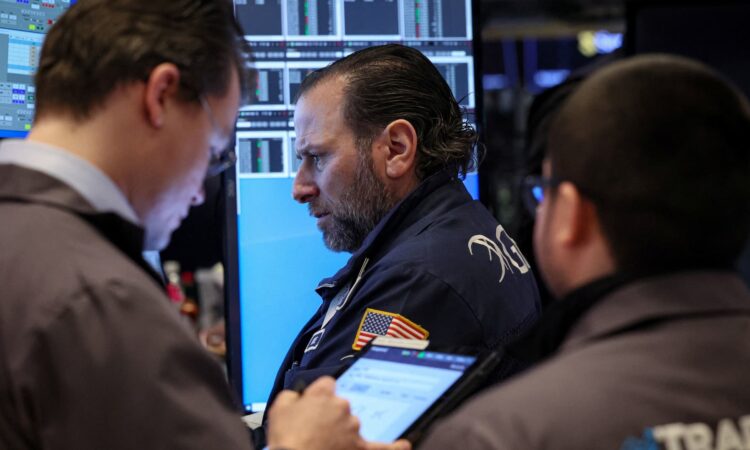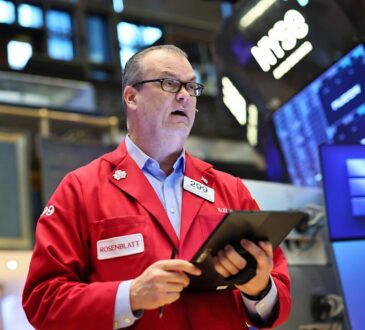The stock market debate is trapped in the ’90s with both bulls and bears drawing comparisons

GenZ fashion influencers aren’t the only ones trying to channel the 1990s these days. Investors likewise see plenty of current-day relevance in that decade of upheaval, renewal, technological acceleration and eventual excess. The main stock-market argument now raging among the orneriest bears and giddiest bulls hinges on what year of the ’90s best matches up with 2024. The market skeptics are busy flagging what they see as parallels between today and 1999, the year the ’90s bull market went parabolic and sentiment came unhinged, building the behavioral and valuation excesses that culminated in the early-2000 peak and subsequent multi-year collapse. The believers in the staying power of the current bull market place us in 1995. This year glows bright in the annals of economic history for its flawless soft landing, when an aggressive Federal Reserve tightening campaign in 1994 gave way to a brief but mostly painless slowdown, followed by modest rate cuts, a reacceleration, a productivity revival and five years of stellar stock-market returns. Nvidia vs. Cisco ’99 The inescapable dominance of a half-dozen Nasdaq giants in driving the S & P 500 above 5000 for the first time by Friday is the central focus of the “1999 redux” crowd. Charts overlaying today’s steep and unflagging surge in Nvidia on that of Cisco Systems from the late-’90s have been circulating for months. Last week, JP Morgan strategist Marko Kolanovic argued in some ways the extreme concentration of the S & P 500 – the top six stocks approaching 30% of total market value – was more severe than near the 1999-2000 peak, given these stocks’ somewhat lower earnings contribution to overall index profits today. Related to this critique is the loud and newly pervasive grousing about the potency of the top-heavy S & P 500 itself, purportedly due to passive flows into index funds and the self-reinforcing need of active stock pickers to chase the largest stocks higher to avoid being left behind. This echoes common complaints back in 1999 that automatic flows into 401k plans — then quite new — along with momentum-chasing mutual funds such as Janus 20 were somehow artificially goosing the big glamour stocks. Value-investing asset manager GMO last week published a study showing that the top ten S & P 500 stocks by size have handily beaten an equal-weighted pool of the other 490 for several years now. This is uncommon relative to the long span of history – since 1957 the largest ten have lagged by an average 2.4% a year. But the other period when the biggest consistently trounced the field was the late-’90s. The run higher in 1999 occurred in a late-cycle, full-employment environment, when rampant excitement over the promise of the Internet and mobile communications fed a broadband-capex boom and skyrocketing valuations for companies geared to it all. The bears hear other echoes, too: Stocks had undergone a stiff gut check in late 1998 as Russia defaulted and big hedge funds failed, spiking financial-system stress and causing the Fed to shift to an easier posture even in a strong economy. Is this something like the response to last year’s mini-regional-bank crisis – at which point the “high quality” secular-growth stocks began to speed away from more leveraged and smaller companies? Valuation, then and now So, do they have a good case? In the vaguest outlines there are similarities with the full-employment AI boom and mega-cap dominance. But in stock performance, scale of valuation extremes and overall behavioral character, it doesn’t seem close. It’s a bit wild that such talk is bubbling up when the Nasdaq Composite has yet to climb back to its peak level from November 2021 – more than 26 months ago. In the 26 months ending Dec. 31, 1999, the Nasdaq was up 150%. Even the better-performing Nasdaq 100 is just 8% above its late-2021 high. Valuation today is perhaps challenging, the Nasdaq 100 at 26-times forward 12-month earnings. But it’s not in the same atmospheric layer as in 1999. Neither is Microsoft, a useful indicator give that it was the largest stock by market cap both in December 1999 and today. Oh, and there were more than 400 IPOs in the year 1999and their average first-day price pop exceeded 90%, not exactly the cautious capital-markets environment we have today, with its dearth of new issues and general neglect of small-cap growth stocks. The pictures of 1999 and today, then, don’t really match up too closely. But, crucially, this doesn’t mean the market is free of risks or excesses and has nothing but blue skies to the horizon. Observing that conditions aren’t now much like the largest bubble in anyone’s lifetime — one that led to a 75% Nasdaq crash and to the S & P 500 being dead money for 13 years — is not saying all that much. The hints that we could be seeing some version of 1995 play out are somewhat encouraging, though — and go some distance toward explaining the way the market has responded to the macro developments of recent months. The Fed, then and now The 1994 Fed tightening campaign prompted a bond-market crash, a few “financial accidents” such as the bankruptcy of Orange County, Calif., and a treacherous, corrective stock market that punished small-cap and financial stocks. But the real economy stayed firm and unemployment rate declined to cycle lows all the while – somewhat like the past two years. In early 1995, then-Fed Chair Alan Greenspan rhetorically pivoted to suggest the next move could be a rate cut, and stocks took flight on a near-45-degree angle all year, even as the Fed ended up delivering just three small cuts from the peak 6% rate (and did so even with the S & P 500 at a record high). The crucial turn here was Greenspan concluding that the labor market could remain tighter than previously believed without flaring up inflation. This is roughly how Fed Chair Jerome Powell has framed things today – though admittedly in 1995 inflation had never become a problem while this cycle it surely did. Indeed, today the stock market has done well even as expectations for the speed and depth of rate cuts this year have diminished. This fits with history. Ned Davis Research strategist Ed Clissold last week showed that equity performance has been vastly better in slow Fed easing cycles than in fast ones. The latter type usually happens in a rapidly weakening economy. The soft landing of 1995 was simply a mid-cycle slowdown, after which labor productivity accelerated (amid a constant thrum of big-company job reductions and restructurings, I might add). With some manufacturing gauges inflecting higher recently along with less-tight bank lending conditions, and an uptick in productivity late last year, this is one plausible way to think about the recent economic phase. We had something similar in 2015 into 2016, shortly after the Fed tried an initial rate hike and halted quantitative easing. Jurrien Timmer, Fidelity’s head of global macro, plotted the current S & P 500 rally off the October 2022 low against the 1995 and 2016 mid-cycle slowdown bottoms and the present path is just about where those other two were at a similar spot. As enticing and persuasive as all this is, it’s worth noting that the broader stock market was more modestly valued in 1995, and investor belief in technological disruption — and the aggressive capitalization of the disruptors — was barely nascent then. The Netscape IPO was late in the summer of 1995, and those of us covering its phenomenal reception were reduced to comparing it to the Boston Chicken debut a few years earlier, because the category of “hot Internet IPO” didn’t yet exist. Current setup It’s fair to say neither 1999 nor 1995 are perfect templates. There are threads of both visible now, though broadly the 1995 cyclical echoes and market action might be within easier reach. As for the market’s current setup, the battle-tested bull market continues to act like one, the S & P 500 able to feed off a firmer-than-expected U.S. economy, an upturn in corporate earnings, still-tame Treasury yields within their three-month range and, yes, the headlong momentum of Nvidia and associated mega-cap playthings. The kind of rare persistence and magnitude of this rally — up 14 of 15 weeks, ahead by 22% over that period and at a new all-time high — usually is more a sign of longer-term vitality than vulnerability. Similar action in the past has generally continued higher over a multi-month time frame, though odds of a near-term rest or reset have risen. The tape isn’t doing much wrong at this point. Reactions to upside earnings surprises is stronger than the norm, and the rally is broader than most are giving it credit for. (Industrials are leading, the equal-weight S & P is up 19% from October and there were 204 new 52-week highs on the NYSE Friday over 24 new lows.) The piping-hot action in momentum stocks, though, has tripped some tactical alarms, with Goldman Sachs’ trading desk on Friday noting a decent chance of short-term reversal in this cohort. The S & P 500 uptrend has for weeks targeted the 5050 area, as an immediate culmination point, and it’s just about there.



